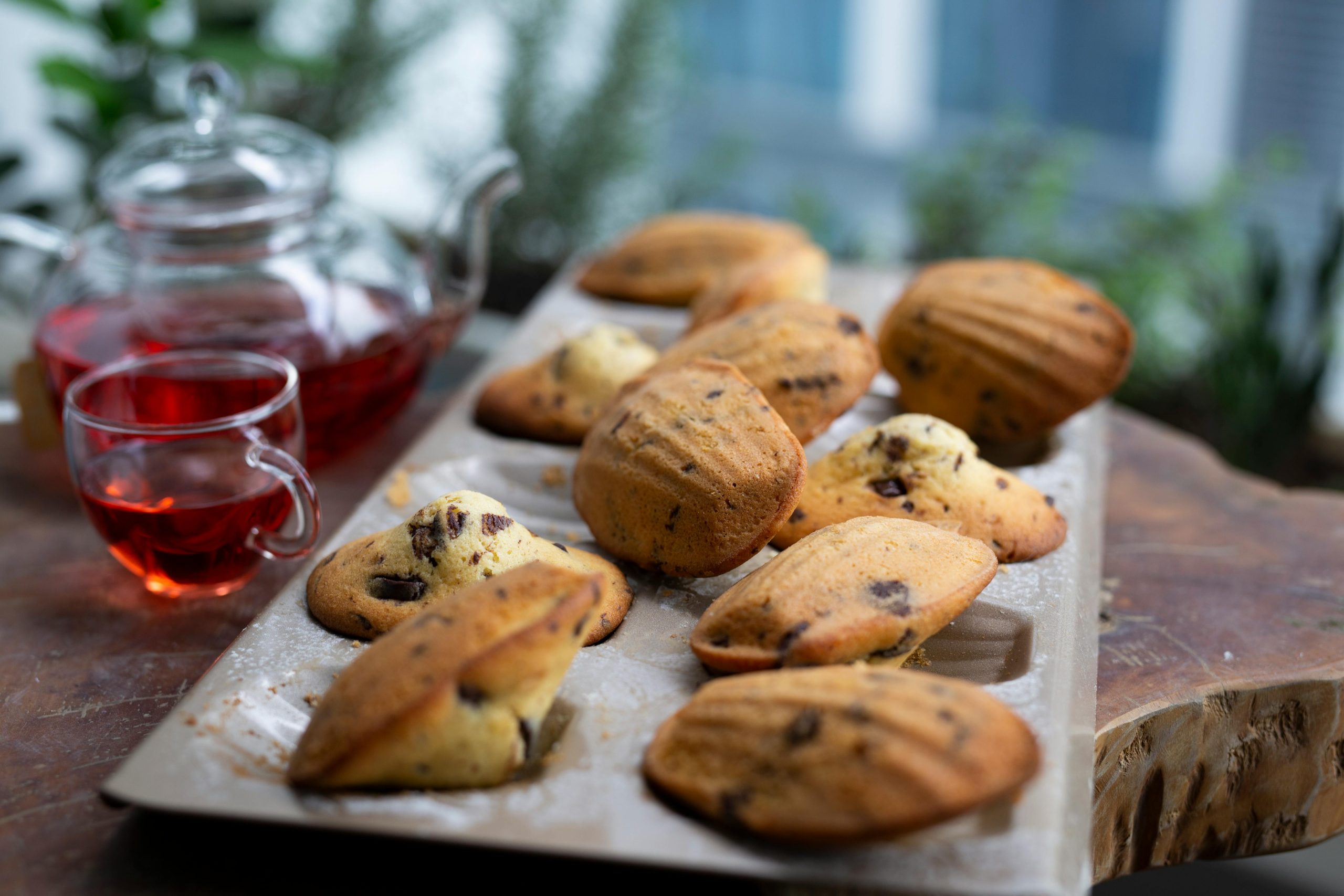What’s the Secret to Perfectly Moist Lemon-Lavender Madeleines?

Making madeleines is not just a culinary skill but an art form. These small, elegant, shell-shaped cakes have been part of French patisserie finest for centuries, and for a good reason. Madeleines are an indulgence, a delight to savor with every morsel. The perfection of a madeleine lies in its moist, spongy texture and flawless blend of flavors. In this article, we delve into the secret of making perfectly moist lemon-lavender madeleines.
The Essential Elements to a Great Madeleine Recipe
Before we journey into the actual process of baking, it’s crucial to understand the essential components of a madeleine recipe. The three primary ingredients are flour, eggs, and sugar. These ingredients form the base for your batter. As a budding baker, you need to remember that the proportions of these ingredients will significantly impact the moisture level of the madeleines.
Lire également : How Can You Infuse a Classic Pecan Pie with Maple Syrup for a Gourmet Twist?
The flour gives structure to your madeleines. For this recipe, we are using all-purpose flour. The proteins present in the flour react with the liquid (eggs and butter) to form gluten, giving your madeleines their characteristic crumb structure.
The eggs are the binding agent in the recipe, holding all the ingredients together. They also contribute to the moisture content of your madeleines. As you whip the eggs with sugar, they will trap air, and this is what gives your madeleines their light, sponge-like texture.
Lire également : How to Create a Rich and Flavorful Vegetarian Lasagna with a Creamy Bechamel?
The sugar in the recipe is more than just for sweetening. It also contributes to the firm crust of your madeleines and aids in achieving a beautiful golden color during baking.
The Role of Lavender, Lemon, and Honey
Now we come to the elements that give our madeleines their unique flavor profile: lavender, lemon, and honey. When you think of a typical madeleine, the first flavor that comes to mind might be vanilla or lemon. But in this version, we’re infusing the timeless madeleine with a fragrant hint of lavender and a touch of honey sweetness.
Lavender provides a unique floral note to the madeleines. When incorporated into the batter, lavender infuses its delicate flavor throughout, making each bite a sensory delight. However, it’s essential to be careful with the quantity of lavender used. You want just a hint of the flavor, not an overpowering taste.
The lemon zest adds a tangy freshness, which complements the sweet honey and balances the floral lavender. The acidity in the lemon also reacts with the baking powder, helping your madeleines rise to their full potential.
Honey, apart from sweetening the batter, also provides moisture to the madeleines. It is a natural humectant, meaning it absorbs and retains moisture, ensuring your madeleines stay moist even after baking.
The Importance of Butter in the Recipe
Butter is another crucial component in madeleines. Not only does it provide richness and moisture, but it also contributes to the beautiful golden color of the madeleines. The milk solids in the butter brown during baking, enhancing the flavor and color of the madeleines.
It’s vital to use unsalted butter in this recipe. Salted butter can throw off the balance of flavors, especially since we’re working with lavender, which is a delicate flavor. Unsalted butter gives you control over the salt content in your recipe and allows the flavors of lavender and lemon to shine through.
Detailed Step-by-Step Baking Process
Now that we’ve covered the key elements in our madeleines, let’s get down to the detailed process of baking.
Firstly, you’ll need to melt the butter and let it cool. This step is vital because if the butter is too hot when added to the batter, it could start cooking the eggs.
Next comes the step of whipping the eggs and sugar together. This process, known as "ribboning," is the secret to achieving that light, spongy texture in your madeleines. You’ll be looking for a pale, thick mixture that leaves a trail or "ribbon" when the beaters are lifted.
The flour is then gently folded into the egg and sugar mixture, followed by the cooled melted butter. It’s crucial to fold gently to avoid knocking out the air that you’ve incorporated during whipping.
Lastly, you add the lavender, lemon zest, and honey. Once the batter is ready, it’s chilled for at least an hour. This step is crucial for achieving the characteristic ‘hump’ on the madeleines.
Once the batter is chilled, you will scoop it into a greased and floured madeleine pan and bake for around 12-14 minutes. The madeleines are done when they’re golden brown and springy to the touch.
And there you have it, perfectly moist lemon-lavender madeleines. It’s not just about the ingredients but also the process and the love that goes into baking. Happy Cooking!
The Significance of Baking Powder and the Perfect Lavender Madeleines
Moving ahead with our delectable lemon-lavender madeleines recipe, we cannot overlook the importance of baking powder. This seemingly unassuming ingredient plays a pivotal role in the overall texture and appearance of madeleines. Baking powder serves as a leavening agent, creating gas bubbles in the batter that expand during baking. This leads to the formation of the distinctive ‘hump’ on the back of the madeleines, a classic trait of these petite French cakes.
In addition to rising, baking powder also contributes to the browning of the madeleines. It creates an alkaline environment, enhancing the Maillard reaction, responsible for the golden-brown hue and the crust’s delicious flavor. However, it is crucial to use just the right amount of baking powder. Too much can leave a bitter aftertaste, while too little won’t allow the madeleines to rise properly.
Now, onto the hero of our recipe, the lavender. For this recipe, we use dried lavender flowers, which are typically more concentrated in flavor than fresh ones. These flowers not only lend a delicate floral note but also add a touch of color to our madeleines. The key is to finely grind the lavender flowers to a powder before incorporating them into the batter. This allows for an even distribution of flavor without the texture of the flowers interrupting the cake’s soft, spongy crumb.
In Conclusion: Lemon-Lavender Madeleines are a Healthy Eating Option
Our journey through the art of baking the perfect lemon-lavender madeleines has been an exciting one. We’ve discovered the importance of each ingredient, the role they play in the final product, and the careful balance that needs to be maintained for the ideal texture and flavor. From the basic ingredients like flour, eggs, sugar, and butter to the unique elements like lavender and lemon zest, each ingredient has a key role to play.
One thing to note is that these lemon-lavender madeleines can be a part of healthy eating. They are lower in sugar and fat compared to many other desserts, and you can regulate the amount of sugar based on your preference. The addition of honey, a natural sweetener, also contributes to the health benefits. Lavender, too, has numerous health benefits, including stress relief and improved sleep.
Finally, remember that the madeleines’ quality is not solely dependent on the ingredients alone but also on the process and care put into baking. From the moment you melt the butter to the point where you take out the golden-brown, aromatic madeleines from the oven, every step is crucial.
So, preheat your oven, prepare your madeleine pan, whip out your dried lavender, and embark on this rewarding journey of baking. Enjoy the process, and most importantly, relish every bite of your homemade lemon-lavender madeleines, a treat worth every bit of your effort!
